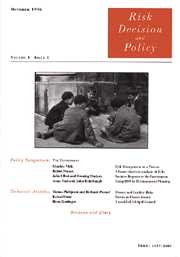Article contents
Better ways of breeding Lizards: simulating three strategies for managing a multistage investment decision task
Published online by Cambridge University Press: 21 November 2002
Abstract
In a multistage investment task the decision maker attempts to increase the capital by committing some part of it over several trials in a risky investment. Despite the richness of experimental results from this task, no decision strategy exists which is able to predict investment behavior. In this paper we formulate three strategies for predicting decisions in the investment task. In the success-expectation strategy (SES), the main factor determining the choice is the expected subjective probability of a success in the coming trial. In the win–loss ratio strategy (WLRS), the main factor is the relation between the possible win and the possible loss in a specific investment situation. In the linear function of capital strategy (LFCS), the available capital is the principal determinant of choice. We tested these strategies with the help of computer simulation, using data from previous experiments. With each strategy we predicted each subject's choices and compared these predictions with the observed decisions. The predictions of WLRS correlated significantly and positively with the observed data for 24 of the 39 subjects (62%), those of LFCS correlated with 14 subjects (36%), and those of SES correlated with nine subjects (23%). The findings reveal previously unsuspected patterns in deploying capital, as well as individual differences in investment behavior. Additional factors influencing strategy use and choices are discussed.
- Type
- Research Article
- Information
- Copyright
- Copyright © Risk Decision and Policy 2002
- 1
- Cited by


